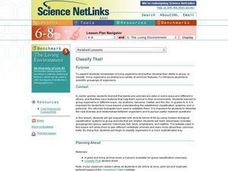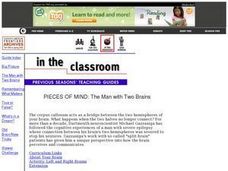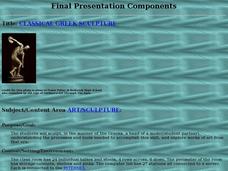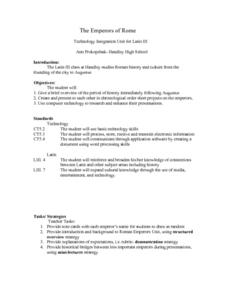Curated OER
You Can Be A Woman Meteorologist
Students complete four activities that are about meteorology. The first activity is for them to explore weather maps. The second activity is for students to discover high-pressure and low-pressure air. The third activity is for them to...
Curated OER
Place Value: Numbers to 9,999
In this place value practice instructional activity, students fill in the missing numbers in the 6 place value sequences. In addition, students write 4 expanded form numbers as standard form numbers and write 4 more numbers using words.
Curated OER
Being in the Noh: An Introduction to Japanese Noh Plays
Students analyze the conventions used in Noh plays and write an introduction to a Noh play of their own. In this Noh play lesson, students identify the conventions of the Noh form and analyze the realizations the main character achieves....
Curated OER
Create a Cat with Amaco Scuptamold and Wireform Metal Mesh
Students create an animal from Sculptamold and metal mesh. In this hands-on arts lesson, students use the materials provided the create a piece of art in the form of an animal. This lesson includes easy step-by-step directions.
Curated OER
How Financial Institutions Help Businesses Grow
Young scholars study various forms of business organizations comparing and contrasting them to practices of the 1870's. They investigate the ways the businesses finance their transactions through loans.
Curated OER
Disease and Nutrition
Students study disease and explore how it can be avoided or treated with simple solutions. In this investigative lesson plan students create a food chart for two weeks for themselves to track and be sure they are getting all...
Curated OER
History of the Universe
Students describe how the universe was formed. For this astronomy lesson, students listen and respond to questions in a PowerPoint lesson that includes various theories about how the universe was created.
Curated OER
Factoring Perfect Squares
In this factoring worksheet, students factor perfect squares. Explanations and examples are provided at the beginning of the worksheet. This two-page worksheet contains ten problems.
Curated OER
Diagonals to Quadrilaterals II
Pupils identify the properties of different polygons. In this geometry lesson, students find the slope of a line and calculate the distance between two lines. They differentiate between similar and congruent polygons.
Curated OER
Drought, nomads and the price of peanuts
Learners read two short text items, which describe different approaches to agriculture. They describe the likely advantages and disadvantages of each approach for farmers, commercial peanut buyers, the government, nomadic herdsman and...
Curated OER
How Volcanoes Grow
Students study volcanoes including rock fragments, ash, aerosols and gases. In this volcano lesson students divide into groups and build models of the three major types of volcanoes.
Curated OER
Classify That!
Students get acquainted with diverse forms of life by using modern biological classification systems to group animals that are related. They explore basic scientific groupings like genus, species, mammals, fish, birds, amphibians, and...
Curated OER
Classify That!
Learners explore diverse forms of life by using modern biological classification systems to group animals that are related. Students then study basic scientific groupings like genus, species, mammals, fish, birds, amphibians, and...
Curated OER
Solar System Socratic Questions
Students reflect on and discuss theories of how the solar system was formed. They respond to prompts in a structured sequence to relate the formation of the solar system and the age of the Earth.
Curated OER
Left and Right Brains
Pupils research the part of the brain known as the corpus callosum. The part of the brain that connects the left and right brain, students investigate its functions and how data passes from one side to another.
Curated OER
Using Tens Frames for "Teen" Numbers
Sixth graders practice recognizing teen numbers for the part-whole strategy of bridging to ten. They approach the advanced counting stage to problem solve addition facts to ten utilizing dot patterns on a quinary frame with dot patterns...
Curated OER
Finding Sums to 6
Students explore the additive identity property where they add multiple numbers to get to the number 6. For this number 6 lesson plan, students also work on their addition charts.
Curated OER
Classical Greek Sculpture
Learners create a sculpture of one of their classmates heads in the manner of the Greek sculptures. They apply the correct terminology into making their sculpture. They evaluate their own project and focus on areas to improve on.
Curated OER
The Emperors of Rome
Students research an emperor assigned to them both form on-line sources and paper sources. They locate at least one image of the emperor or a building he authorized to use in their presentation. They create a 5-10 minute presentation to...
Curated OER
Causes of the Civil War
Young scholars research information on the causes of the Civil War. They rank their top three reasons and individuals responsible for the war and then use that information to write a position paper.
Curated OER
Enjoyable Assessments
First graders participate in two place value games for review. In groups, they work together to assess themselves before their test over place values. They review any questions they have before their assessment.
Curated OER
Hands-on Cells
Students review the components of a cell and the differences between plant and animal cells by creating a three-dimensional model of each type of cell. In small groups, they use modeling clay and household object to construct their models.
Helping with Math
Identifying and Writing Decimals up to Thousandths
A simple learning exercise asks learners to write five numbers in decimal form. Sets of blocks represent the numbers and include whole number blocks, tenths, hundredths, and thousandths. Use this to follow other worksheets by the same...
Curated OER
Understanding Place Value
Fifth graders study place value. After forming teams, they play a game called, "Who Can Line Up the Number." Students observe numbers in expanded form and place representative digits in the correct order.























